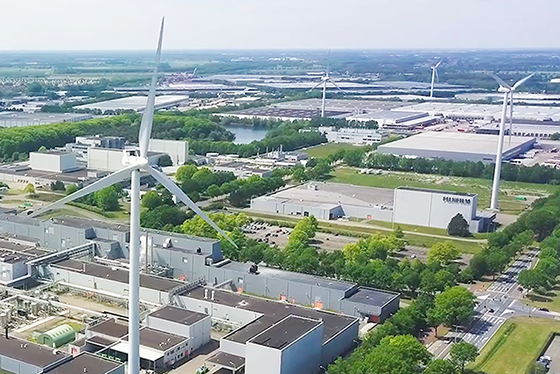The Fujifilm Group aims to fully operate on carbon-free energy to achieve net zero CO2 emissions by FY2040, and to reduce CO2 emissions by 50% (compared to FY2019) across the entire product lifecycle, including phases such as procurement of materials, manufacturing, transportation, usage, and disposal, by FY2030.
In order to achieve these targets, we will promote the manufacturing with a lower environmental impact and the creation and promotion of products and services with excellent environmental performance under the Fujifilm Group's environmental strategy, “Green Value Climate Strategy”.
(FUJIFILM Manufacturing Europe B.V./Netherlands)
FUJIFILM Manufacturing Europe B.V., located in Tilburg, the Netherlands, manufactures photo color paper and cell culture media and remanufactures toner cartridges. The plant switched to wind energy for all of its power needs. Specifically, five wind turbines built on the site in 2011 generate 35% of the electricity used at the facility (actual results for FY2024, YTD). The remaining 65% is supplied by wind power energy suppliers.
In several buildings and in some manufacturing processes where high-temperature steam is required, natural gas is used as fuel. To reduce this natural gas usage, an electric boiler that runs on wind-sourced power to heat water and generate steam, has been introduced at the plant*1. Through further implementation of the electric boiler, combined with additional heat-pumps, FUJIFILM Manufacturing Europe aims to achieve carbon neutrality*2 by FY2030, ten years ahead of the total Group’s goal.
- *1 For more details, please refer to the news release below.
- *2 Zero CO2 emissions from manufacturing (Scope 1 and 2)

Multiple wind turbines installed on the site
(FUJIFILM Healthcare Manufacturing Sano Site)
FUJIFILM Healthcare Manufacturing Corporation manufactures endoscopy systems at its Sano Site in Sano City, Tochigi Prefecture for diagnosis and treatment of lesions, including in the stomach and large intestine. Solar panels have been installed on the rooftop of the manufacturing facilities or on the ground to enable conversion to renewable energy and reduced CO2 emissions step by step.
In FY2023, the facility where endoscopy systems are assembled achieved substantial conversion of all used electricity to renewable energy*3 through the installation of solar panels and energy-saving practices.
The site is also introducing a “smart factory” system that boosts production efficiency through the use of AI and IoT technologies. Some processes that once required manual labor have been automated, helping to reduce operating time, which also reduces power consumption. The site will continue to make efforts with the aim of achieving carbon neutrality*4 for the entire site in the future.
- *3 Including the application of renewable energy certificates (certificates that certify the “environmental value” of electricity generated from renewable energy).
- *4 Zero CO2 emissions from manufacturing (Scope 1 and 2)
Flow synthesis is a method of mixing or reacting material chemicals in a continuous flow in a fine column with a diameter of between several hundred microns to a few millimeters. Compared to batch synthesis, in which large amount of raw materials are mixed and reacted at once in a large reaction vessel, flow synthesis is suitable for various manufacturing scales.
In addition, the batch synthesis method may require a large facility to keep the entire reactor vessel cool to prevent rapid reactions occurring in some part of the vessel, while the flow synthesis method requires the cooling only a small reaction zone, leading to significant energy savings.
Fujifilm has developed a new synthetic method for this flow synthesis method, utilizing our proprietary technology*5 to further enhance productivity and energy efficiency. By applying this new method to produce “arylboronic acid derivatives,”*6 we found that compared to traditional batch synthesis, it significantly reduces the amount of raw materials and waste generated, as well as the energy required for cooling. This results in a reduction of CO2 emissions by approximately 53% for the same production volume. After assessing these environmental performance, Fujifilm Group has awarded this synthetic method the highest rank, “Diamond,” in our “Green Value Products” certification program.
- *5 Technology to design mixers and heat exchangers that maximize reaction efficiency based on chemical reaction engineering.
- *6 Arylboronic acid derivatives are used as key raw materials and intermediates in the production of a wide range of chemical products, including raw materials for pharmaceuticals.








